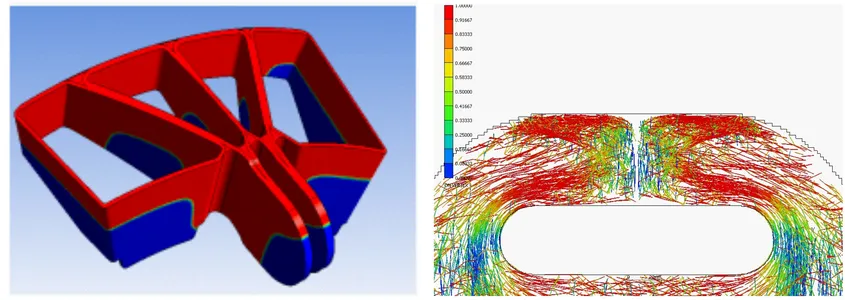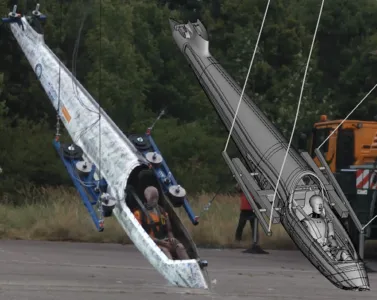A wide variety of filling and flow processes are simulated at the Chair of Carbon Composites. These include, among others:
• RTM, VARI, Compression RTM (figure left)
• Injection molding
• SMC and BMC (figure right)
The aim of virtual processes is to avoid possible defects in the final component and to make the process itself more robust. The simulations allow, for example, to predict the dry spots in the part, the filling time, possible weld lines or the fiber orientation. The information from one process step can also be transferred to subsequent simulations.
Technical details
• Software: ANSYS Fluent, PAMRTM, OpenFoam, 3DTimon, Moldflow
• High Performance Cluster of the LRZ
Contact person
Dr.-Ing. Dennis Bublitz
The temperature has a significant effect on the viscosity of the plastics used and therefore influences the manufacturing process itself as well as the properties of the final part. For this reason, many processes are also analyzed with thermal simulations at the Chair of Carbon Composites. These include, among others:
• 3D printing to predict the layer bonding (figure left: Infrared camera image of the process; figure right: thermal simulation).
• Temperature distribution in the molds in the RTM process
• Cooling simulations to predict component distortion
• AFP simulation to optimize the temperature profile
• Thermoforming of organo-sheets
Predicting the temperature distribution during the manufacturing process allows to optimize the production and to increase the quality of the finished component.
Technical details
• Software: Abaqus, Ansys, PAM Form, PAM RTM, Matlab
• High Performance Cluster of the LRZ
Contact person
Dr.-Ing. Dennis Bublitz
A wide variety of forming processes are simulated at the Chair of Carbon Composites. These include, among others:
• Draping of fabrics or NCFs (figure left)
• Thermoforming of organo sheets
• Compaction of preforms in the RTM process or of prepregs (figure right)
The aim of virtual processes is always to avoid possible defects in the final component and to make the process itself more robust. The simulations allow, for example, to predict the wrinkle formation, the fiber orientation or the fiber volume content. The information from one process step can also be transferred to subsequent simulations.
Technical details
• Software: ANSYS mechanical, Abaqus, LSDyna, PAMForm
• High Performance Cluster of the LRZ
Contact person
Dr.-Ing. Dennis Bublitz
The modelling of short-term dynamic events, such as those that can occur in a vehicle accident or a bird strike in aviation, is a crucial competence in the development process of safety-relevant composite structures. At TUM-LCC therefore explicit finite element solvers are used in conjunction with strain rate-dependent material models. The material cards are of particular importance for the prediction quality of the simulation. Special measurement technology for dynamic material characterization in our own laboratory is used to parameterize them.
The failure behavior of composites results from a large number of micromechanical damage processes, which cannot be directly modelled in dynamic simulations of large structures due to the high computational effort involved. Research at the TUM-LCC therefore focuses on multiscale simulation approaches and the selection of the optimum modelling approach for the respective application.
Dynamic simulations can fulfil various functions:
• Virtual design of energy-absorbing structures
• Evaluation of damage of dynamically loaded components
• Reduction of cost-intensive physical tests
• Evaluation of the occupant load in a crash
Technical details
• Software: Abaqus Explicit, LSDyna
• High Performance Cluster of LRZ
• Strain rate-dependent material cards
Contact person
Marco Tönjes, M.Sc.
Fatigue occurs in various materials and shows as crack initiation and crack growth under cyclic loads. Whereas fatigue has been investigated for over a century for metals and is thus well understood, the fatigue-resistant design of composites is a comparably young field of study. Accordingly, only few design guidelines and modelling tools exist for composite structures subjected to cyclic loading. Nevertheless, composite materials have shown to be able to withstand hundreds of millions of load cycles in large structures like wind turbine rotor blades.
At TUM-LCC, several modelling techniques are utilised to predict the fatigue performance of fibre-reinforced polymers (FRPs) at multiple scales (from micro to macro scale). A combination of commercially available finite element solvers and in-house developed numerical and analytical tools allows for the estimation of the fatigue life or the remaining strength of composite structures. Hereby, a core aspect is the computational efficiency of these models. Different approaches exist for modelling the entire operational range of composites from a few hundred cycles (low-cycle fatigue, LCF) to several millions of cycles (ultra-high-cycle fatigue, UHCF). Additionally, not only constant-amplitude loads but also time-varying loads (as they appear in out-of-lab environments) can be efficiently modelled.
A calibration and validation of the fatigue models can be carried out following the building block approach.
Technical Details
• Software: Abaqus CAE including user subroutines, in-house tools written in Python/ Matlab
• High Performance Cluster of the LRZ
Contact person
Alexander Seidel, M.Sc.
Various quasi-static structural simulations and design optimizations are carried out at the Chair of Carbon Composites. These include, among others:
• Long fibre-reinforced structures such as hydrogen tanks, sport equipments or medical products
• Short fibre-reinforced structures from 3D-printing or injection moulding
• 3D-printable structures with and without fibre-reinforcement
Our simulation frameworks usually solve a multiscale analysis problem, where microscopic behavior must be captured at a simulation of macroscopic component level. Typically, composite elasticity, plasticity and damage, as well as 3D-printing inherited effects must be modelled at the microscale level to be able to simulate the full-scale components. Composite lay-up and sizing optimizations as well as design topology optimization of 3D-printable structures complete our simulative lightweight targets.
Technical details
• Software: Abaqus, ANSYS Mechanical, Optistruct, Matlab
• High Performance Cluster of the LRZ
Contact person
Oliver Schwahofer, M.Sc.





